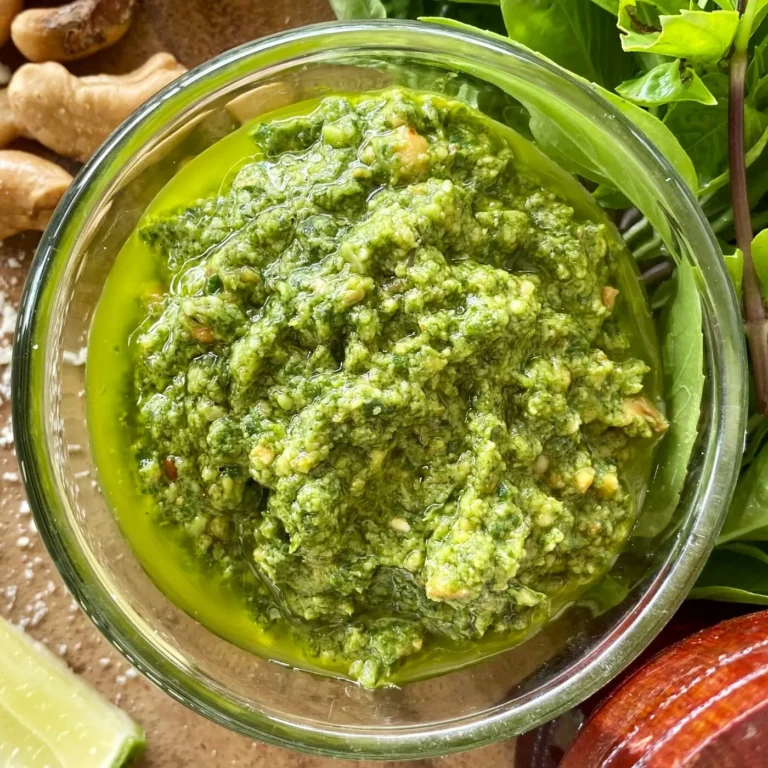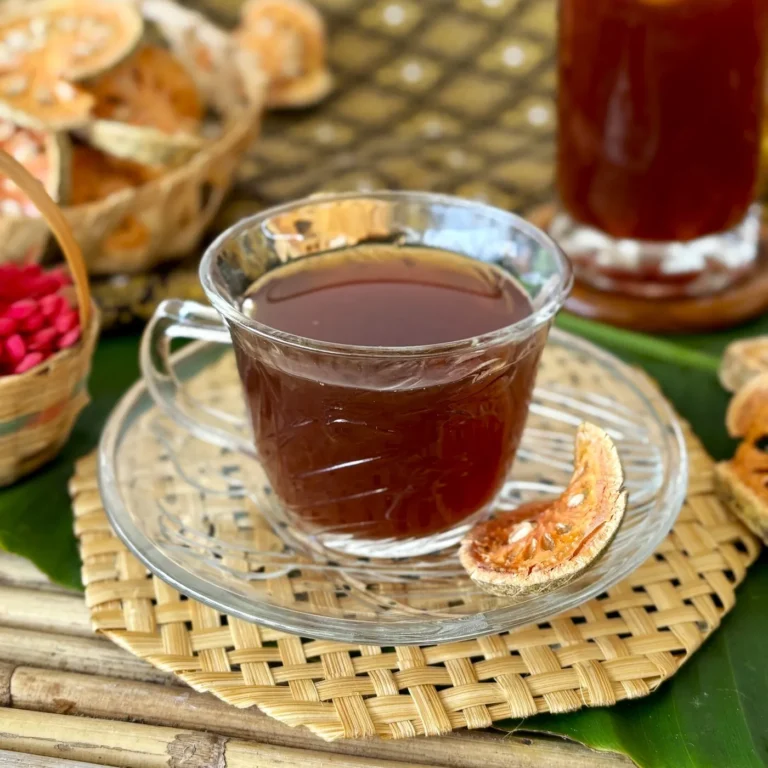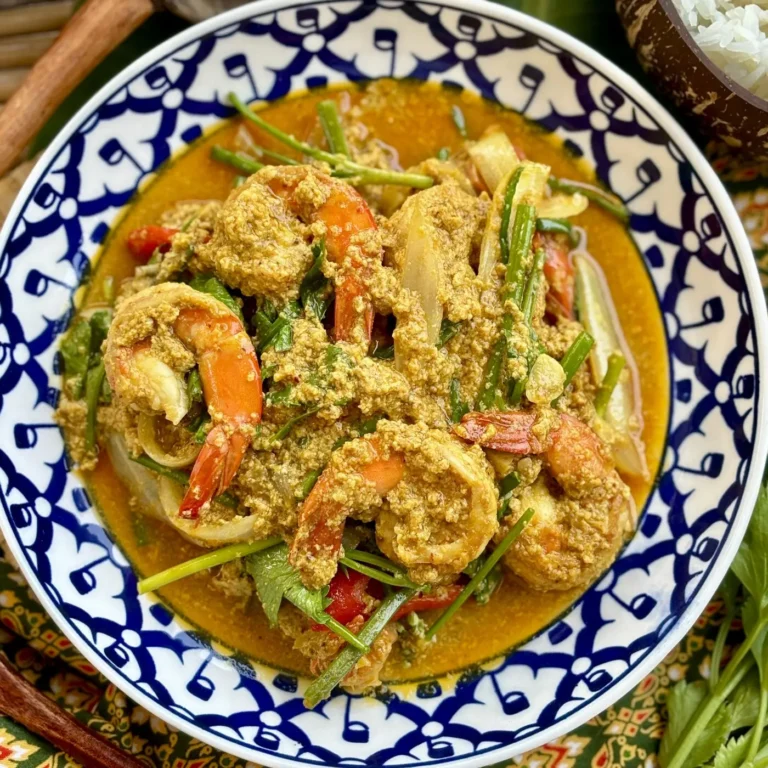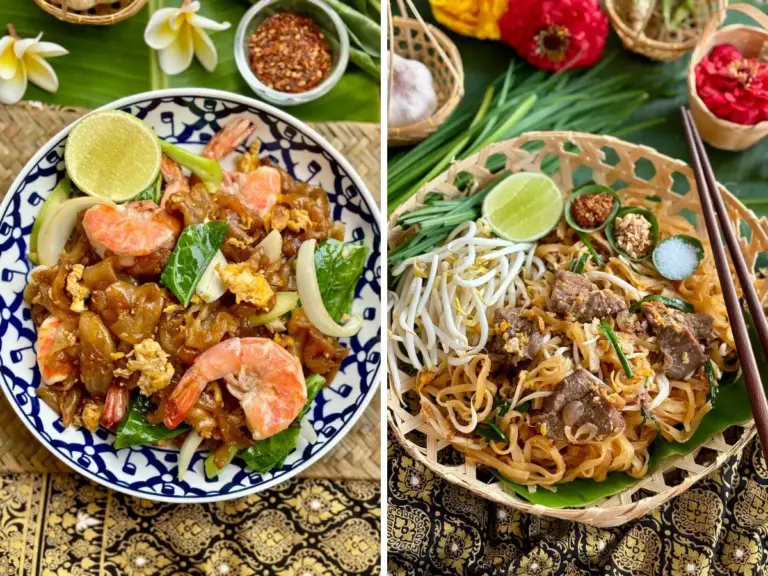Issan Thai food recipes with sticky rice that clings to your fingers and the smoky deliciousness of grilled meats. These are the kind of dishes that make my life worth living. They’re a symbol of rural Thai life and they’re here for you to try. You’ll even get a closer look at the Northeastern Thai culture, with the inside scoop from a local.
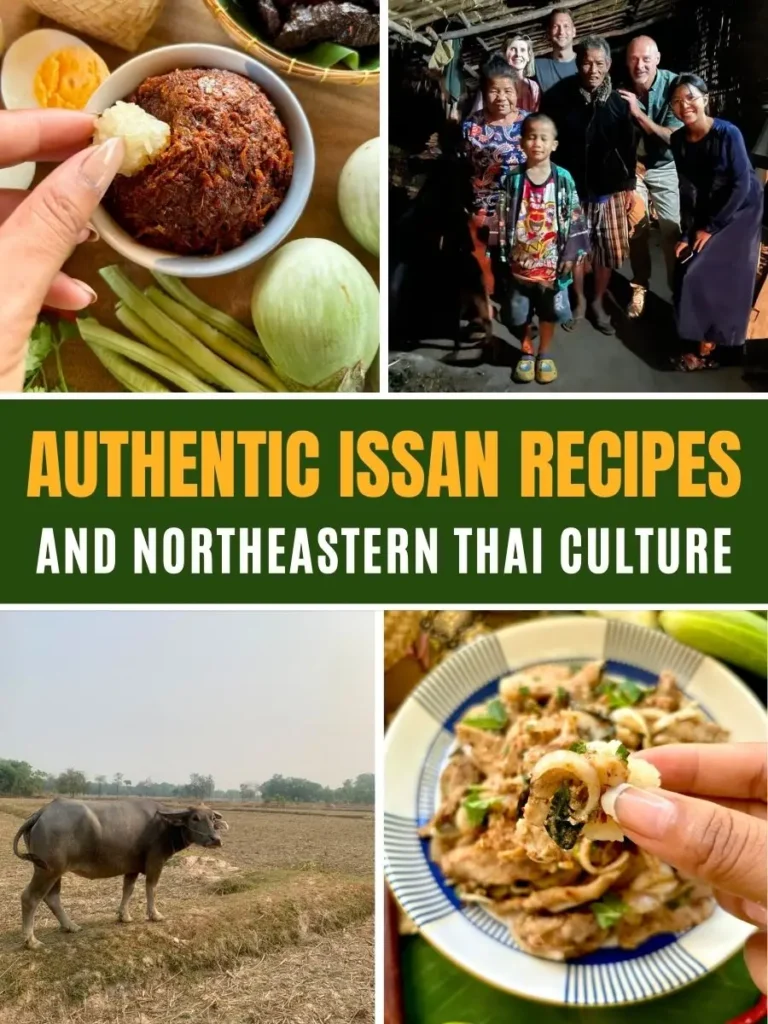
You might also like my collection of healthy Thai food recipes for 2024!
Learn more about the traditional Isan cuisine with unique recipes from a local, and discover why Northeastern Thailand is a must visit for anyone who loves good food.
These traditional Isan recipes are easy, delicious, and perfect for any day of the week. But first, let’s take a closer look at what makes Isan food so different.
What is Isan?
Isan is the Northeastern region of Thailand and is known for its laid-back lifestyle and strong cultural identity. This area, marked by its rice field landscapes and lively cultures, is bordered by the Mekong River, separating Laos and Thailand.
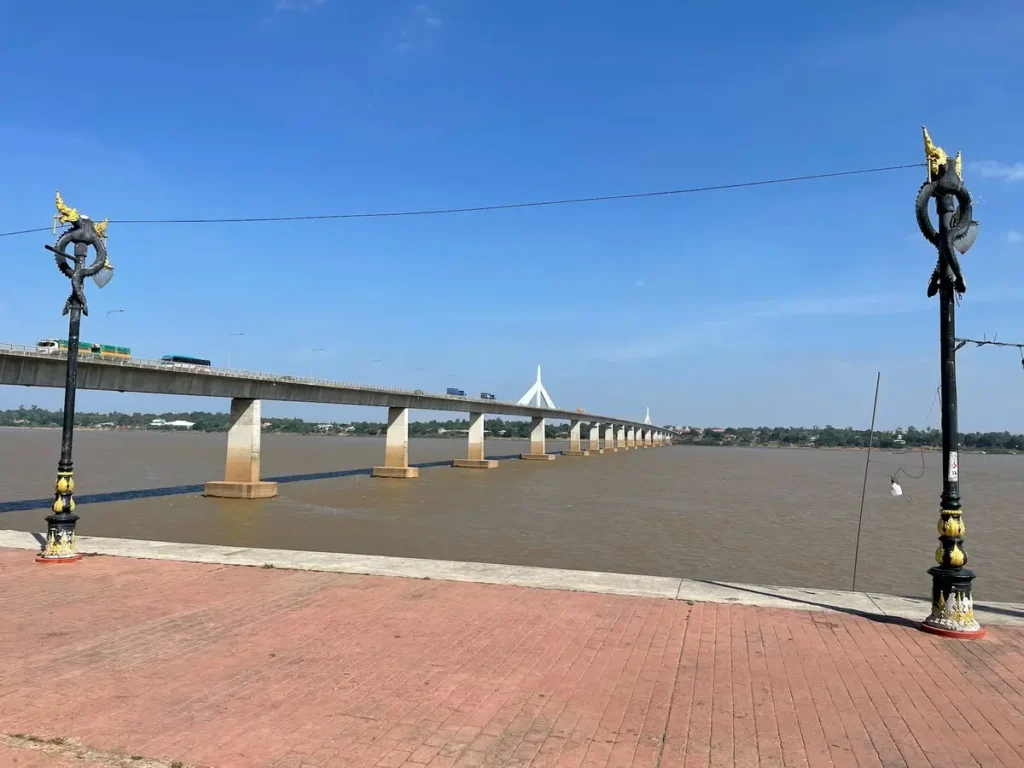
What is Isan food?
Isan food, originating from Northeastern Thailand, is a unique cuisine known for its spicy dishes, Thai sticky rice, and use of fresh vegetables. Classic staples include papaya salad, grilled meats, grilled fish, and even wild ingredients like mushrooms, red ant eggs, and insects.

Insects? Yep, you read that right! Insects and mountain rats are somewhat of a delicacy here, especially amongst the elders.
Northeastern Thailand
Northeastern Thailand, often overlooked by tourists, is truly a place of its own.
Here, amidst endless rice fields and local street food markets, life moves at a different pace. It’s a life that’s far from the chaos of Bangkok – it’s a simpler, down-to-earth way of living.

I love the slow-paced way of life in and strong family ties in rural Thailand, and I wouldn’t trade if for a thing.
While Isan is often labeled as the ‘poor side’ of Thailand, it’s actually a region rich in culture and tradition. It’s simply a different way of living. I’ve known Thai people who own extensive land yet choose the humble life in a small wooden cabin amongst the rice fields over a modern house and car.

Northeastern Thai people are known to be hardworking folks, deeply connected to their land and rice fields, passed down through generations. Communities in the villages are tight, where everyone supports one another in every way imaginable.

In Isan, every street corner and food market tells a story. It may not have the glitz of the big cities, but it offers something far more precious. It’s a window into a simpler, more genuine Thailand.
Isan is a place where the rhythmic pounding of mortars and pestles and the warmth of local interactions make you slow down and savor every moment.
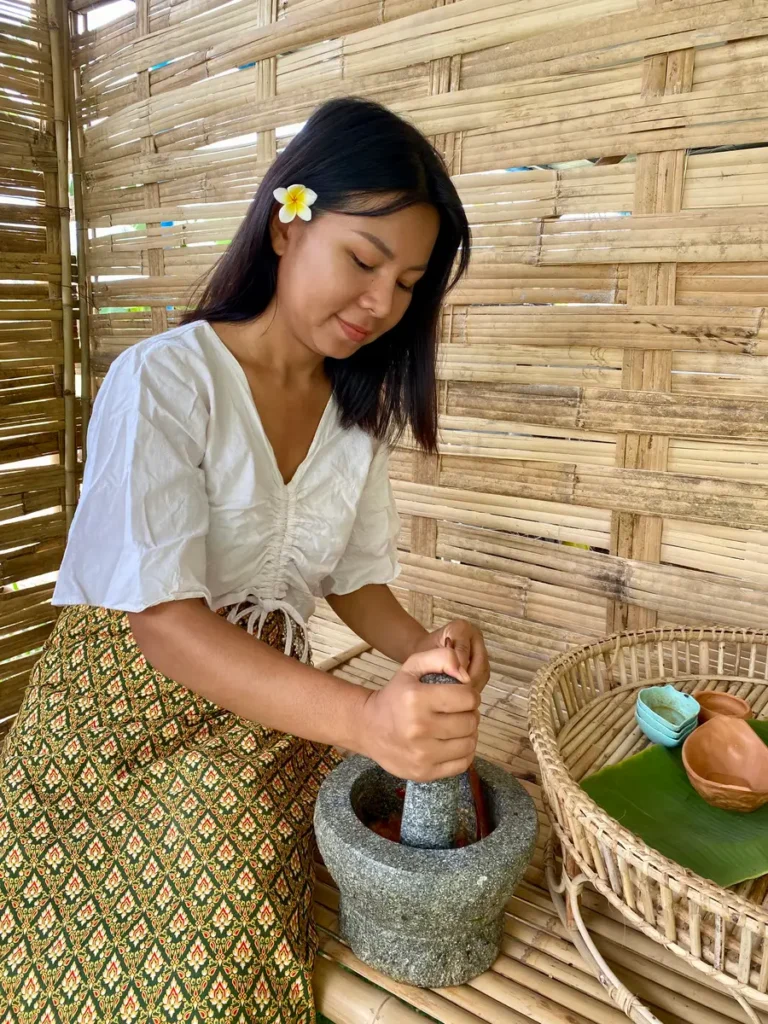
Thai Issan food
Thai Issan cuisine is all about communal eating and shared joy. Picture a bamboo table gathered with family and friends, the air filled with the smoky scent of grilled meats and the strong scent of ‘lao khao’, a cheap Thai whiskey.

Som tam pla ra, a spicy green papaya salad with the tang of lime and pungent fermented fish sauce, is a staple. Thai pork larb, with a blend of minced meat, fresh herbs like mint and coriander, and mouth-burning spices, is a must-try.
Here are some more unique larb recipes you’ll love: fried chicken larb with crispy chicken, shrimp larb recipe with whole shrimp, and mushroom larb recipe with enoki mushrooms.
Steamed sticky rice is a daily thing for Isan residents. Its chewy texture is the perfect side for dipping into our spicy sauces, soaking up the flavorful juices of grilled meats like moo yang.
In Isan, we love Thai hot pot, grilling, sun-drying, and deep-frying. The sizzle of grilled meats, the chewiness of Thai beef jerky, and the crispy perfection of fried fish are just a few of our favorites.
Our traditional Thai cuisine might surprise you with its simplicity. It’s months of hard work for rice, which is a labor of love. Some families, like our neighbours, even make their own charcoal! And let’s not forget those unique ingredients – mountain rats, frogs, buffalo, and wild crab – that add a touch of the wild to our dishes.
My grandmother’s soups like this Thai bamboo soup, filled with fresh vegetables and wild forest ingredients like mushrooms, raised my husband’s eyebrows at first. But now, they are on our weekly dinner rotation.
All these dishes, some a bit unusual to most tourists, are a symbol of our land and our way of life.
Thai vs Lao food
Isan and Lao cuisine are like brother and sister. Both kitchens share a love for bold flavors with fresh herbs, spicy chilies, and that umami of fermented fish sauce and shrimp paste.
Every meal is a communal feast, where everyone gathers around a big pot of sticky rice, ready to dive into spicy Thai salads, Thai dipping sauces, and amazing chili pastes.
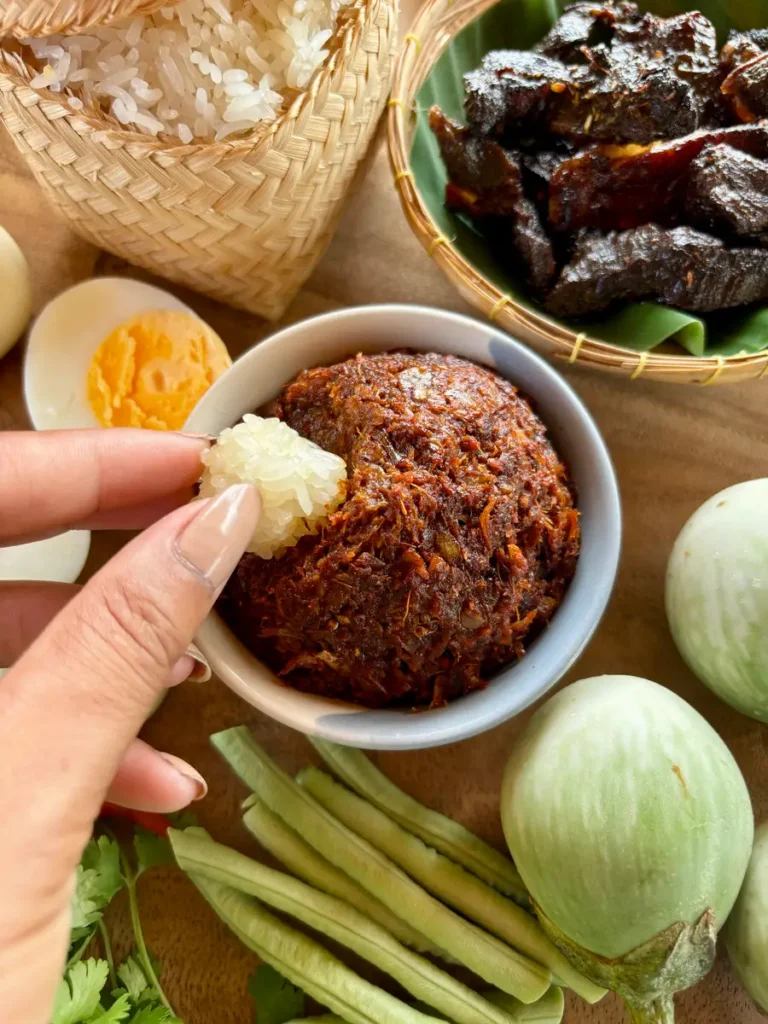
The Lao dipping sauces and salads listed in the recipes below are some my favorites, they’re an absolute dream. These Isan and Lao recipes are easy to make at home and offer the perfect balance of salty, sweet, sour, and spicy.
Isan Thai food recipes
Ready to try your hand at some of the best Northeastern Thai recipes? They’re a fantastic mix of spicy, sour, sweet, and salty – the real deal, people. These are my must-try Isan and Lao dishes, perfect for any home cook!
1. Thai sticky rice

A must-have with almost every Isan meal, Thai sticky rice is steamed to perfection and perfect for scooping up sauces, salads, and grilled meats. It’s chewy, filling, and always served warm in little baskets.
2. Pla som

Pla som is a fermented fish dish with a slightly sour flavor and soft, flaky texture once fried. It’s often made at home and served crispy on the outside and tender inside—usually with sticky rice and fresh chili on the side.
3. Sai krok Isan
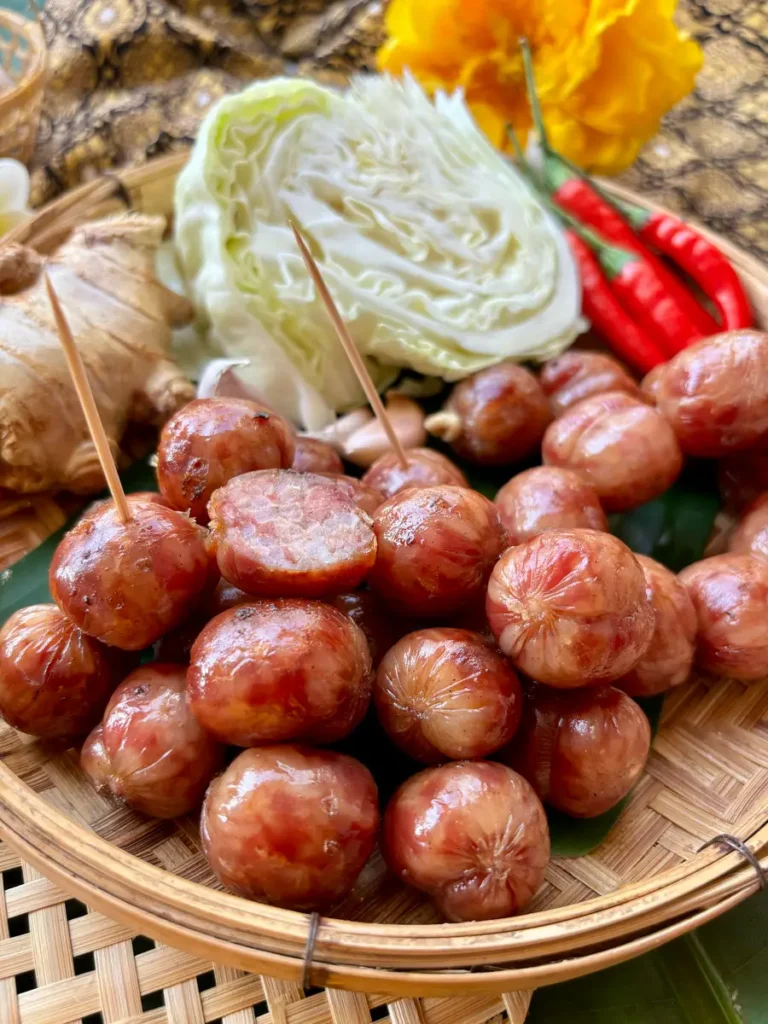
These garlicky, slightly sour fermented sausages are grilled until the skin is crisp and the inside juicy. You’ll often see them served with cabbage, fresh chilies, and sticky rice for a classic Isan street food combo.
4. Beef larb

Beef larb is bold, spicy, and packed with roasted rice powder, fresh herbs, and lime juice. It’s a fiery minced meat salad that’s best enjoyed with sticky rice and crisp veggies.
5. Clear Thai soup
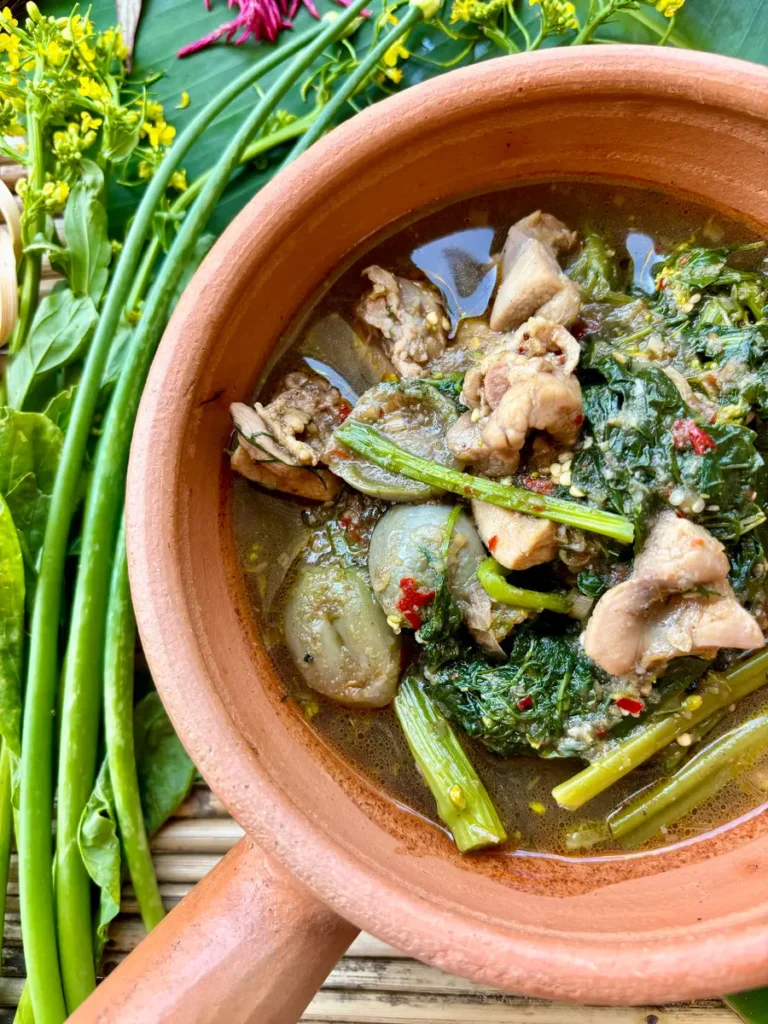
This light, broth-based soup is often simmered with soft vegetables and pork or chicken. Gaeng om gai is mild and comforting—great for balancing out spicier Isan dishes.
6. Pla pao

Pla pao is whole fish stuffed with herbs, coated in a thick salt crust, and grilled over charcoal until perfectly juicy.
7. Khao lam
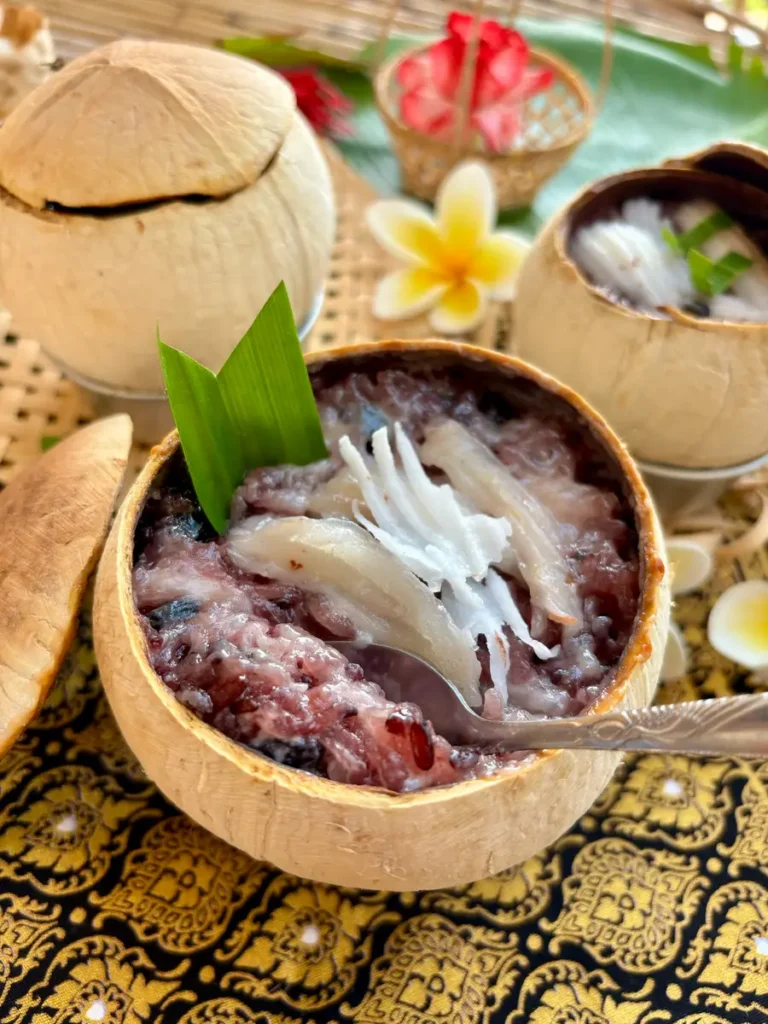
Sticky rice mixed with coconut milk and black beans, packed into bamboo tubes and slow-roasted over fire. It’s sweet, slightly smoky, and a beloved traditional dessert or snack called khao lam.
8. Nam tok moo
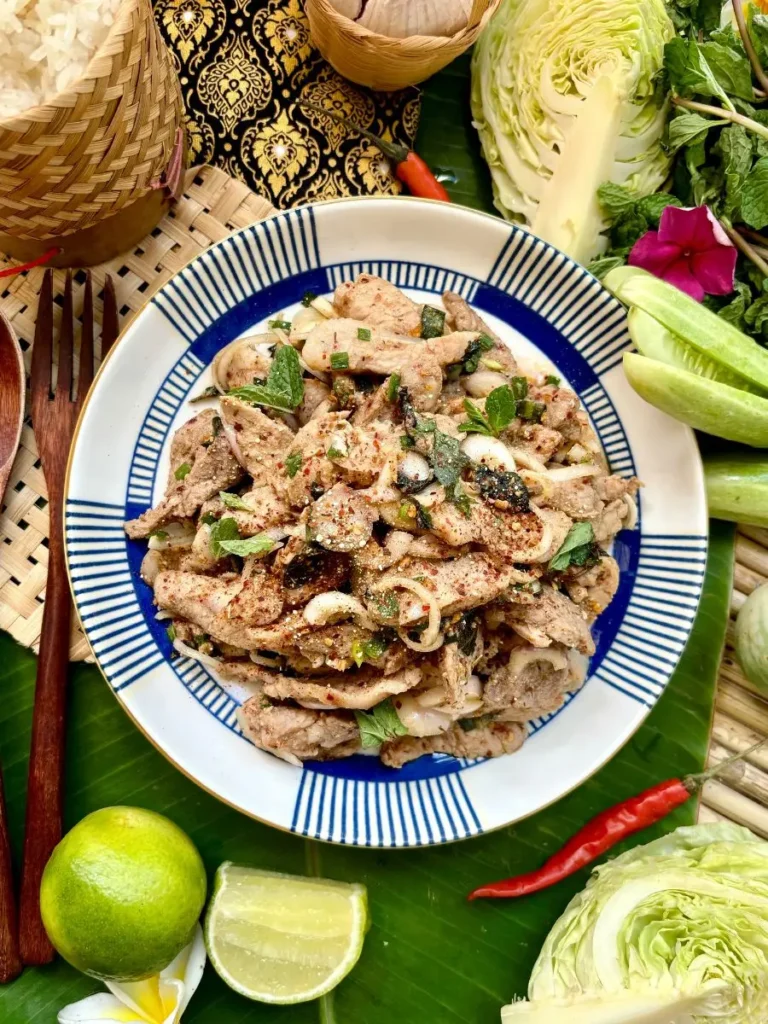
Nam tok moo is a grilled pork salad with a tangy dressing, toasted rice powder, and a kick of chili. It’s similar to larb but with juicy slices of grilled meat instead of minced.
9. Beef jerky

Sun-dried, deep-fried beef strips that are chewy, salty, and full of flavor. Sun-dried beef is perfect for snacking with sticky rice and a spicy dipping sauce.
10. Thai bamboo soup

A traditional bamboo soup made with young bamboo shoots, local herbs, and sometimes mushrooms.
11. Pork jerky

Moo dad deaw are strips of marinated pork dried in the sun and lightly fried for a sweet-salty bite. Often eaten with sticky rice or tucked into a lunchbox for road trips.
12. Moo yang

Grilled pork marinated in garlic, soy sauce, and a touch of sugar, then charred over open flame. It’s juicy, smoky, and usually dipped in spicy jaew sauce.
13. Crying tiger steak

Tender grilled beef, sliced thin and served with a bold dipping sauce known as jaew. Crying tiger is a must-try if you love meat!
14. Khao jee

Sticky rice patties grilled with a coating of egg until crisp on the outside and soft inside. You’ll find them being made fresh on street corners across Isan.
15. Grilled chicken

Isan-style grilled chicken is marinated with garlic, coriander root, and fish sauce, then slowly grilled until golden and flavorful. Served with sticky rice and papaya salad, it’s a true local favorite.
Mortar and pestle
A Thai mortar and pestle is the heart of many authentic Isan dishes. It’s the secret to those crazy delicious flavors.

For many Isaan locals, their day starts by waking to the sounds of crackling chickens. Then, firing up their pots of sticky rice and the sound of a mortar and pestle grinding chilies, garlic, and herbs fills the air. Another day filled with delicious meals to come.
A mortar and pestle is not just about mixing the ingredients. It coaxes out flavors in a way that food processors and blenders can’t replicate, releasing natural juices and aromas.
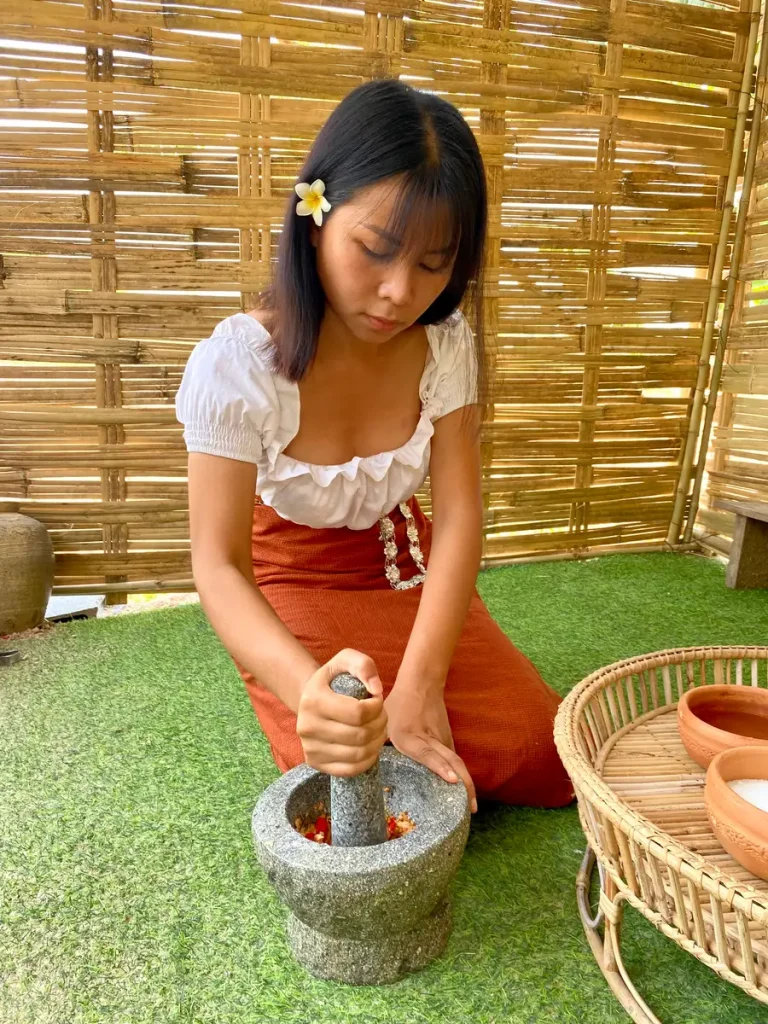
It’s a staple in every Isaan kitchen, and for good reason.
Don’t forget to check out my collection of simple mortar and pestle recipes later!
Isan-style food in the west
How did Isan food hit the streets of Bangkok, and ultimately find its way to the Western part of the globe?
Isan locals, in hopes of finding better work opportunities, packed their bags filled with dreams and recipes passed through generations. They head to central Thailand, Bangkok. Bangkok is a city that never sleeps, full of tourists and locals. After a time, sticky rice and spicy salads popped up everywhere, and everyone loved it – tourists and locals.
Fast-forward a bit, and you’ve got lots of people from the West totally in love with Thailand. Some marry Thai people and bring back a slice of our rich culture. One of the go-to businesses for Thai people in the West is food tents – serving up delicious Thai dishes.
Okay, finding that 100% authentic Thai food flavor in the West is a tough job, but it’s definitely a little sneak peek into the heart of Thailand. While Thai food in the West is not exactly like Thailand, it’s a great way to get that quick fix of spicy, sour, salty, and sweet.
Northeastern vs Southern Thai cuisine
The first time I tasted a REAL Southern Thai dish, it took me by surprise! It was way more salty than what I’m used to. Let’s take a closer look at the two unique regions.
Northeastern Thai cuisine
Wandering through an Isan market, you might smell the pungent flavors of fermented fish sauce and shrimp paste, but that’s the charm of it.
- Salads: Two staple dishes are som tam pla ra (papaya salad with fermented fish sauce) and raw larb.
- Natural ingredients: Fresh greens from the local fields to the plate.
- Spicy with a flavor balance: A fiery kick tamed by a hint of sweetness, salty, and sour.
- Fresh vegetables & sticky rice: The daily staples of Isan cuisine.
Southern Thai cuisine
In the South, the ocean’s breeze mingles with the scent of simmering spices. Here’s what you’ll find:
- Rich, spicy curries: These curries are very herbaceous, strong, and rich in flavor. They’re deep and complex, quite thick, and can be super salty but also balanced.
- Fresh seafood: Thanks to the nearby sea, the seafood is as fresh as it gets. Tom yum soup with the freshest seafood you can find? Yes please!
- Salty and spicy: Bold and utterly delicious.
- Aromatic: Every stir-fry and curry is full of aroma and fresh flavors.
Some delicious Southern Thai recipes to try: Khua kling recipe, a Thai dry mince curry – kaeng som, a sour curry – and this delicious Thai roti dessert.
Frequently asked questions
Is Isan food spicy?
Yes! Isan food is known for its bold, spicy flavors, where chilies are a key ingredient. Spicy dishes like som tum (green papaya salad) and larb (spicy meat salad) are just a few of the daily staples in the Northeastern Thai region.
What is Thai Isan language?
Thai Isan, commonly referred to as Isan and different from Central Thai, is the unique dialect spoken in Northeastern Thailand. It shares its roots with the Lao language, making certain words and phrases similar.
Is Isan food suited for vegetarians?
Isan is known for meat-heavy dishes, some recipes can be adapted for vegetarian using tofu or mushrooms. Additionally, the region is known for its bamboo soup, which can be made vegetarian.
What are common herbs and spices in Isan cooking?
Lemongrass, galangal, kaffir lime leaves, toasted rice powder, and a variety of fresh and dried chilies are used on a daily basis.
I want to eat Isan food but I can’t eat spicy!
Kai yang (grilled chicken) with a side of fresh vegetables and sticky rice is a perfect start.
What is fermented fish sauce?
Fermented fish sauce, a staple in Isan cuisine, is a savory, umami-rich condiment made by fermenting fish and salt. This process lasts several months, yielding a deeply flavorful sauce that’s essential in traditional Isan dishes like som tam.
COnclusion
Discover my collection of easy Thai recipes and Thai breakfast recipes next!
Issan Thai recipes are a mix of bold spices, fresh flavors, and natural ingredients. The next time you’re in the mood for something different, why not try some of these authentic Isan recipes? If you liked this little journey into the Northeastern Thai culinary traditions, cuisine, and staples, please leave a comment below! Follow me on Facebook, Instagram, and Pinterest.


